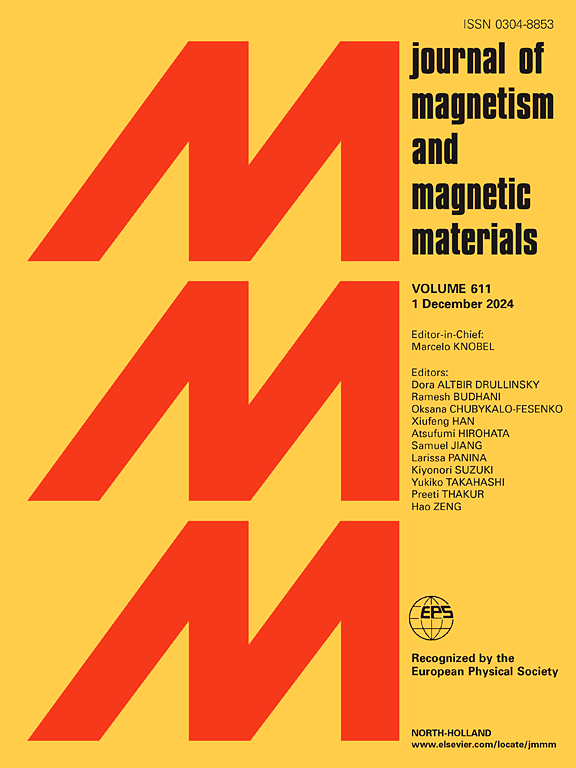Exploring the three-field coupling mechanism of temperature-magnetic stress relief in electrical metal materials
IF 2.5
3区 材料科学
Q3 MATERIALS SCIENCE, MULTIDISCIPLINARY
引用次数: 0
Abstract
This paper presents a comparative investigation into the efficacy of temperature-magnetic stress relief (TMSR) applied to silicon steel, along with an analysis of the ensuing microstructural changes post-TMSR treatment. The findings reveal that TMSR exhibits a remarkable “1 + 1 > 2″ reduction effect. Following TMSR treatment, there is a notable increase in dislocations within the material, accompanied by a rise in parallel domains that are uniformly distributed. Furthermore, density functional theory simulations were conducted on Fe crystals subjected to varying temperature fields to examine changes in crystal properties and elucidate the mechanism behind TMSR’s reduction and enhancement effects. The simulation outcomes indicate a consistent upward trend in crystal atomic magnetic moment with increasing temperature, regardless of stress levels, suggesting a pronounced thermos-magnetic coupling strengthening effect. This phenomenon constitutes the primary mechanism driving the attenuation and enhancement effects observed with TMSR. Additionally, systematic calculations were performed to assess the mechanical properties of the crystal under different temperature conditions. The results demonstrate a continuous softening of the crystal with increasing temperature, eventually leading to a phase change upon surpassing a critical temperature threshold.
探讨电性金属材料中温度-磁应力消除的三场耦合机理
本文对硅钢的温度磁应力消除(TMSR)效果进行了对比研究,并分析了TMSR处理后的显微组织变化。结果表明,TMSR表现出显著的“1 + 1 >;2 .″还原效果。在TMSR处理后,材料内的位错显著增加,同时均匀分布的平行畴增加。此外,通过密度泛函理论对不同温度场下的Fe晶体进行了模拟,研究了晶体性能的变化,并阐明了TMSR的还原和增强效应的机理。模拟结果表明,无论应力水平如何,晶体原子磁矩随温度升高呈一致的上升趋势,表明存在明显的热-磁耦合强化效应。这种现象构成了驱动TMSR观测到的衰减和增强效应的主要机制。此外,系统地计算了晶体在不同温度条件下的力学性能。结果表明,随着温度的升高,晶体不断软化,最终在超过临界温度阈值时导致相变。
本文章由计算机程序翻译,如有差异,请以英文原文为准。
求助全文
约1分钟内获得全文
求助全文
来源期刊

Journal of Magnetism and Magnetic Materials
物理-材料科学:综合
CiteScore
5.30
自引率
11.10%
发文量
1149
审稿时长
59 days
期刊介绍:
The Journal of Magnetism and Magnetic Materials provides an important forum for the disclosure and discussion of original contributions covering the whole spectrum of topics, from basic magnetism to the technology and applications of magnetic materials. The journal encourages greater interaction between the basic and applied sub-disciplines of magnetism with comprehensive review articles, in addition to full-length contributions. In addition, other categories of contributions are welcome, including Critical Focused issues, Current Perspectives and Outreach to the General Public.
Main Categories:
Full-length articles:
Technically original research documents that report results of value to the communities that comprise the journal audience. The link between chemical, structural and microstructural properties on the one hand and magnetic properties on the other hand are encouraged.
In addition to general topics covering all areas of magnetism and magnetic materials, the full-length articles also include three sub-sections, focusing on Nanomagnetism, Spintronics and Applications.
The sub-section on Nanomagnetism contains articles on magnetic nanoparticles, nanowires, thin films, 2D materials and other nanoscale magnetic materials and their applications.
The sub-section on Spintronics contains articles on magnetoresistance, magnetoimpedance, magneto-optical phenomena, Micro-Electro-Mechanical Systems (MEMS), and other topics related to spin current control and magneto-transport phenomena. The sub-section on Applications display papers that focus on applications of magnetic materials. The applications need to show a connection to magnetism.
Review articles:
Review articles organize, clarify, and summarize existing major works in the areas covered by the Journal and provide comprehensive citations to the full spectrum of relevant literature.
 求助内容:
求助内容: 应助结果提醒方式:
应助结果提醒方式:


